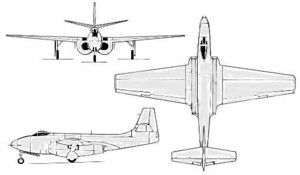PlaneSpottingWorld welcomes all new members! Please gives your ideas at the Terminal.
Bell XP-83
| Bell XP-83 | |
|---|---|
| S/n 44-84990 in test flight over Wright Field, May 1945 | |
| Type | Escort fighter |
| Manufacturer | Bell Aircraft Corporation |
| Designed by | Charles Rhodes |
| Maiden flight | 25 February 1945 |
| Status | Project cancelled 1947 |
| Primary user | United States Army Air Forces (intended) |
| Number built | 2 |
| Program cost | US$4.2[1] |
| Developed from | P-59 Airacomet |
The Bell XP-83 was an American prototype escort fighter designed by the Bell Aircraft Corporation that first flew in 1945. As an early jet fighter, its limitations included a lack of power and it was soon eclipsed by more advanced designs.
Contents
Design and development
The early jet fighters consumed fuel at a prodigious rate, which severely limited their range and endurance. In March 1944, the USAAF requested Bell to design a fighter with increased endurance, and formally awarded a contract for two prototypes on 31 July.
Bell had been working on its "Model 40" interceptor design since 1943. It was redesigned as a long-range escort fighter, retaining the general layout of the P-59 Airacomet. The two General Electric J33-GE-5 turbojet engines were located in each wing root, which left the large and bulky fuselage free for fuel tanks and armament. The fuselage was an all-metal semimonocoque, capable of carrying 1,150 US gallons (4,350 L); in addition, two 250 US gal (950 L) drop tanks could be carried. The cabin was pressurized, and the canopy a small and low bubble type. The armament was to be six 0.5 in (12.7 mm) machine guns in the nose.
Testing
Early wind tunnel reports had pinpointed directional instability but the "fix" of a larger tail would not be ready in time for flight testing. [2]The first prototype was flown on 25 February 1945, by Bell's chief test pilot Jack Woolams, who found it to be underpowered and unstable. The limited flight testing provided satisfactory flight characteristics although spins were restricted until the larger tailfin was installed. In the end, the second prototype did incorporate the extended tail and an aileron boost system. [3] One unique characteristic was the XP-83's refusal to "slow down," partly attributable to its aerodynamics as well as the inadequacy of its flaps; test pilots were forced to fly very long and flat approaches.[4]
The first prototype was used in 1946 as a ramjet testbed, with an engineer's station located in the fuselage behind the pilot and on 14 September one of the ramjets caught fire - the pilot "Slick" Goodlin and engineer Charles Fay had to parachute out. The second prototype flew on 19 October and was scrapped in 1947. Apart from range, the XP-83 was inferior to Lockheed's P-80 Shooting Star, and the XP-83 project was cancelled in 1947.
Specifications (XP-83)
Data from War Planes of the Second World War[5]
General characteristics
- Crew: 1 pilot (engineer's station fitted to first prototype, with an entrance door under the fuselage)
- Length: 44 ft 10 in (13.67 m)
- Wingspan: 53 ft 0 in (16.15 m)
- Height: 15 ft 3 in (4.65 m)
- Wing area: 431 ft² (40.0 m²)
- Empty weight: 14,105 lb (6,400 kg)
- Loaded weight: 24,090 lb (10,930 kg)
- Max takeoff weight: 27,500 lb (12,500 kg)
- Powerplant: 2× General Electric J33-GE-5 turbojets, 4,000 lbf (18 kN) each
Performance
- Maximum speed: 522 mph (453 knots, 840 km/h) at 15,660 ft (4,775 m)
- Range:
- Internal fuel: 1,730 mi (1,500 nm, 2,785 km)
- With drop tanks 2,050 mi (1,780 nm, 3,300 km)
- Internal fuel: 1,730 mi (1,500 nm, 2,785 km)
- Service ceiling: 45,000 ft (14,000 m)
- Rate of climb: 5,650 ft/min (28.7 m/s)
- Time to altitude: 11.5 min to 30,000 ft (9,100 m)
- Wing loading: 56 lb/ft² (273 kg/m²)
- Thrust/weight: 0.33
Armament
- Guns:
- 6× .50 in (12.7 mm) M2 machine guns or
- 6× .60 in (15.2 mm) T17E3 machine guns or
- 4× 20 mm (0.787 in) Hispano cannons or
- 1× 37 mm (1.46 in) cannon in the nose
References
- Green, William. War Planes of the Second World War - Fighters (Vol. 4). London: Macdonald, 1961. No ISBN.
- Knaack, Marcelle Size. Encyclopedia of US Air Force Aircraft and Missile Systems: Volume 1 Post-World War II Fighters 1945-1973. Washington, DC: Office of Air Force History, 1978. ISBN 0-912799-59-5.
- Koehnen, Richard C. "Bell's No Name Fighter." Airpower, Vol. 12, no. 1. January 1982.
External links
Related content
Designation sequence
- Pre-1948 USAAC/F:
- Post-1948 USAF:
Related lists
Fighter aircraft: YFM-1 · P-39 · P-59 · P-63 · XP-77 · XP-83
Commercial Helicopters: 47 · 204 · 205 · 206 · 210 · 212 · 214 · 222 · 230 · 407 · 412 · 417 · 427 · 429 · 430
Military Helicopters: H-13 · UH-1 · 207 · 209 · AH-1 · 309 · YAH-63 · OH-58 · ARH-70
Tiltrotors: V-22 · BA609 · TR918 · QTR
Experimental aircraft: X-1 · X-2 · X-5 · X-20 X-22 · XV-3 · XV-15 · 533 ·
Lists relating to aviation | |
|---|---|
| General | Timeline of aviation · Aircraft · Aircraft manufacturers · Aircraft engines · Aircraft engine manufacturers · Airports · Airlines |
| Military | Air forces · Aircraft weapons · Missiles · Unmanned aerial vehicles (UAVs) · Experimental aircraft |
| Notable incidents and accidents | Military aviation · Airliners · General aviation · Famous aviation-related deaths |
| Records | Flight airspeed record · Flight distance record · Flight altitude record · Flight endurance record · Most produced aircraft |

